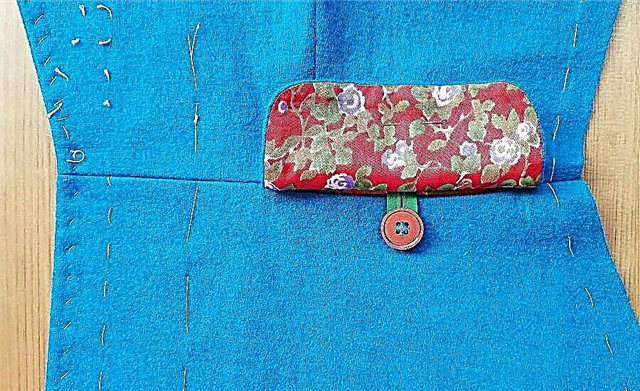Few wardrobe items do without pockets. They can conquer the original form or unusual finish. And they can be exclusively utilitarian as internal pockets or pockets in a seam.

A flap pocket is one of the most common and effective pockets. It is not only functional, but also a decorative element, visually balancing the upper and lower parts of the product.
Inspiration: Pockets as an Art
In this master class, we will consider the processing of a pocket with a flap in the seam of attaching a peplum jacket.
- Special offer

- 1
- 2
- 3
- 4
- Special offer

- 1
- 2
- 3
- 4
- Special offer

- 1
- 2
- 3
- 4
- Special offer

- 1
- 2
- 3
- 4
This technology can also be used when processing pockets in a dress with a cut-off waist or yoke, for example, in dresses in the Chanel style or in the style of Kate Middleton.
How to sew a tweed dress Kate Middleton
- Special offer

- 1
- 2
- 3
- 4
- Special offer

- 1
- 2
- 3
- 4
- Best-seller
- Special offer

- 1
- 2
- 3
- 4
You can add such pockets to the undercuts of the skirt, to the seam of the coquette, or to the seam of the belt.
- Special offer

- 1
- 2
- 3
- 4
- Special offer

- 1
- 2
- 3
- 4
- Special offer
- 1
- 2
- 3
- 4
Step 1. Preparing the pattern and cutting

Prepare patterns for flap pocket and burlap.
1) The length of the entrance to the pocket is 12-14 cm (depending on the size of the pattern).
2) The size of the valve in the finished form: width about 6 cm, length 1 cm more than the entrance to the pocket.
3) The size of the burlap: the width of the burlap is equal to the length of the entrance to the pocket, the length of the burlap is 12−16 cm. The upper section of the burlap repeats the shape of the seam of the grind of the basque. Fractional thread is located as well as on the main parts.

The amount of processing allowances
Carve:
- valve parts from the main fabric - 2 pcs .;
- valve parts made of lining fabric - 2 pcs .;
- valve adhesive seal - 2 pcs .;
- burlap pocket - 4 pcs.
Cut out the gasket of the valve without allowances for take-off, along the seam of the grind, allowance is 0.7-1 cm.
Step 2. Valve Processing

Duplicate valve parts from main fabric with adhesive pad.

Cut 3 mm to the flap of the valve on the lining parts.

Place a lining on the main part with the sides facing inward, equalize the slices. Sweep with oblique stitches, fitting the main part on the curves.

Iron the fit of the main part 1 cm wide from the cut. Grind valves 7 mm wide on the lining side.

Notch rounding allowances. Release valves, sweep out edging with oblique stitches on the lining side and iron. Lay the finishing stitch on the machine either manually or by securing the piping with fluffy stitches on the lining side.
Step 3. Processing pocket entry

At the fitting, determine the location of the pockets. The board should not block the pocket valve. Mark the pocket entries on the basques details. Cut the adhesive edge 2-3 cm longer than the entrance to the pocket.

Glue the edge to the allowance at the pocket entry area so that the edge of the edge falls into the seam by at least 1 mm.

Place burlap on the main part with the sides facing inwards. Pull or pin along the line of entry into the pocket, releasing a lining of 1.5−2 cm at the ends of the pocket.

Lay a line on the layout of the entrance to the pocket. Put notches in the corners, not reaching the line of 1 mm.

Unscrew the burlap, fasten the burlap to the seam allowance with a seam to the edge only along the long side of the pocket entrance. Knit the edging along the entrance to the pocket with oblique stitches. Iron.
Step 4. Burlap processing

Cover the pocket with the second burlap with the sides facing inward, even the slices, chop or bast.

Grind burlap. Seam allowances up to 1 cm and overcast.
Step 5
The fastening of the pocket prevents the pocket from sagging under the load of its contents.
You can sweep the loop on the valve and sew a decorative button. And you can fasten your pocket on the inner loop.
For the inner fastener, the button must be thin so as not to protrude the valve. It can be located both outside the pocket directly under the valve and on the inside of the pocket inside the burlap, which makes it invisible.

Prepare an oblique loop:
- Stitch the trim in half, bending the slices inward;
- roll the loop by fixing the corner manually or by machine stitching.
Buttonhole length = button diameter + 3 cm.
Place the loop in the center of the pocket entrance.

To catch the valve.

Stitch the valve.

Stitch the basques to the shelf, exactly in the seam of the valve. Iron the seam allowances. Move valve allowance up.

Front pocket view.

Sew a button on the thread leg.
Sew a button and make a leg of thread, like a real pro
The author of the master class and photo: Elena Lenkova

Lena has a higher and special education - a tailor of outerwear for men, women and children.
In clothes, he values individuality and thoughtfulness of the image, originality of cut. He likes to analyze modeling techniques and product processing technology. Leads his page on Instagram.
Lena teaches at the Burda Academy and teaches the Men's Shirts and Men's Trousers courses.
"The quality of processing and the interior decoration of the product are integral aspects of sewing."
Material prepared by Julia Dekanova



